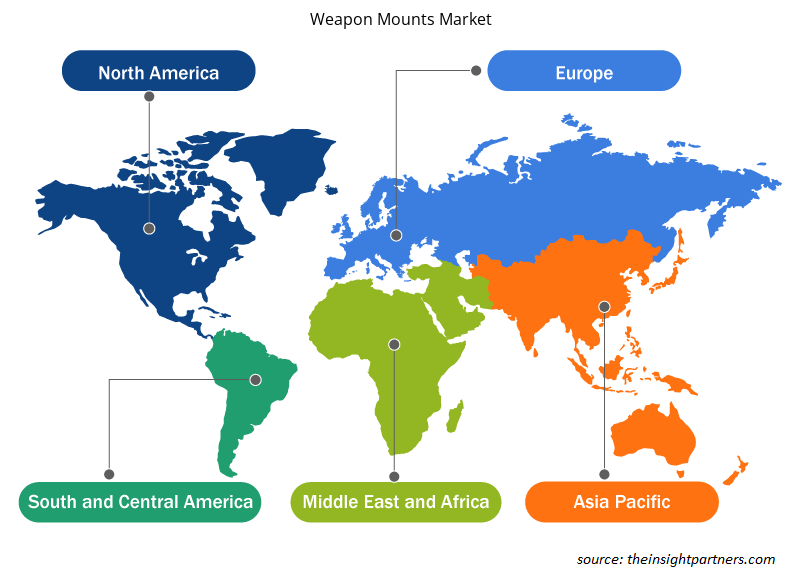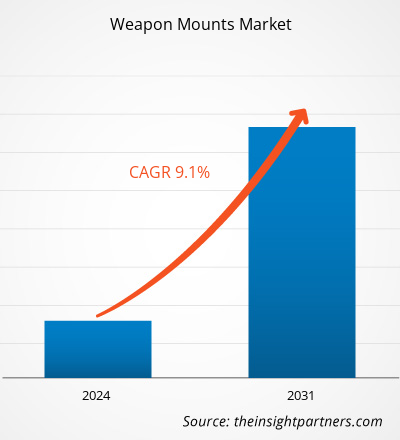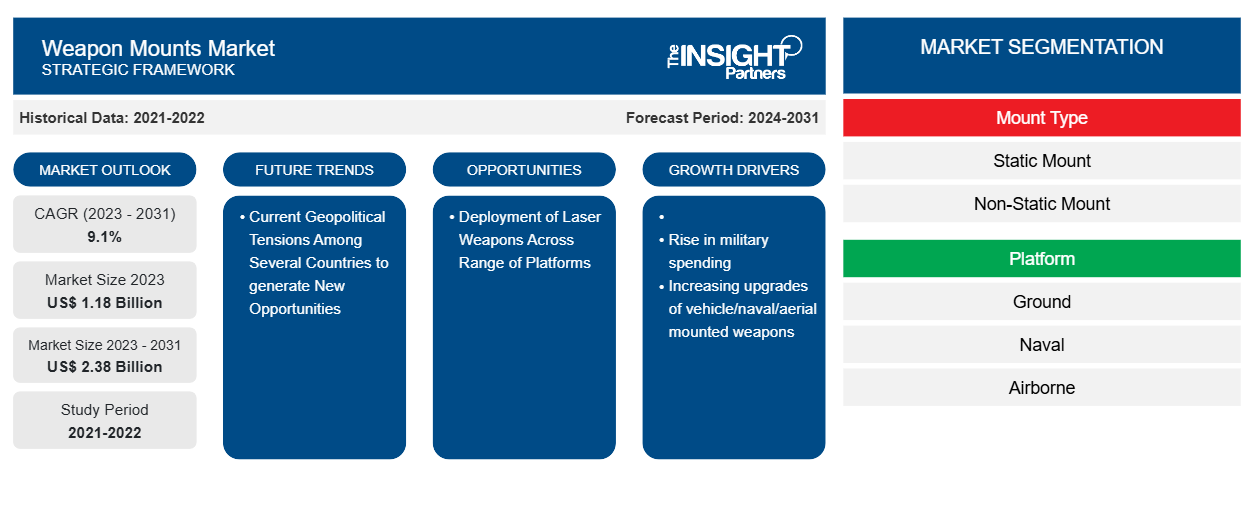Si prevede che la dimensione del mercato dei supporti per armi raggiungerà i 2,38 miliardi di dollari entro il 2031, rispetto agli 1,18 miliardi di dollari del 2023. Si prevede che il mercato registrerà un CAGR del 9,1% nel 2023-2031.
Le varie piattaforme gestite dai contractor includono veicoli blindati, installazioni fisse, portaerei, cacciatorpediniere, fregate, corvette, elicotteri d'attacco, aerei da combattimento, aerei per missioni speciali e altri. Il governo assegna contratti a vari fornitori per prodotti di montaggio di armi. Poiché i supporti per armi sono considerati componenti essenziali, la domanda per gli stessi è elevata tra i dipartimenti militari e della difesa, nonché tra il governo del paese.
Analisi del mercato dei supporti per armi
Gli stakeholder chiave nel mercato dei supporti per armi sono i fornitori di materie prime, i produttori di supporti per armi e gli utenti finali. I produttori si procurano costantemente materie prime dai fornitori per produrre volumi maggiori di supporti con l'obiettivo di soddisfare le richieste dei clienti. Le materie prime utilizzate nella produzione di supporti per armi includono metalli come acciaio inossidabile , alluminio e combinazioni di leghe. La disponibilità di un gran numero di fornitori di materie prime consente ai produttori di supporti di scegliere il fornitore appropriato. Ciò migliora la catena di fornitura delle materie prime. Dopo aver acquistato le materie prime, gli OEM di supporti per armi producono volumi significativi di soluzioni di montaggio con dimensioni, peso e altri parametri variabili, soddisfacendo così le rispettive richieste dei clienti. Gli utenti finali nel mercato dei supporti per armi includono forze militari tra cui esercito, marina e aerospaziale. Questi utenti finali richiedono volumi significativi di supporti per montare vari tipi di armi su piattaforme come aerei da trasporto, veicoli blindati, elicotteri d'attacco, aerei da caccia, cacciatorpediniere e altri.
Panoramica del mercato dei supporti per armi
È probabile che il mercato dei supporti per armi assista a una forte crescita nel periodo 2023-2031. La domanda di mercato dei supporti per armi è guidata principalmente da alcuni fattori chiave quali:
- Aumento della spesa militare
- Aumento degli aggiornamenti delle armi montate su veicoli/navali/aerei
- L'implementazione di sistemi di guerra elettronica spinge la domanda di supporti per armi
- Dispiegamento di nuove postazioni d'armamento in diversi paesi.
È probabile che tali fattori determinino la crescita del mercato dei supporti per armi nei prossimi anni.
Personalizza questo report in base alle tue esigenze
Riceverai la personalizzazione gratuita di qualsiasi report, comprese parti di questo report, o analisi a livello nazionale, pacchetto dati Excel, oltre a usufruire di grandi offerte e sconti per start-up e università
-
Scopri le principali tendenze di mercato in questo rapporto.Questo campione GRATUITO includerà analisi di dati che spaziano dalle tendenze di mercato alle stime e alle previsioni.
Driver e opportunità del mercato dei supporti per armi
Distribuzione di nuove stazioni di armi in diverse regioni
L'aumento del numero di stazioni di armi in diverse regioni è uno dei principali fattori che spingono l'approvvigionamento di supporti per armi in tutto il mondo. Ad esempio,
- Ad aprile 2024, l'esercito statunitense ha schierato un nuovo lanciamissili nelle Filippine. Il nuovo lanciatore terrestre dell'esercito statunitense, in grado di supportare i missili da crociera Tomahawk e SM-6, è apparso per la prima volta nell'Indo-Pacifico in uno spiegamento nelle Filippine settentrionali per esercitazioni militari.
- Nell'ottobre 2023, il Pentagono degli Stati Uniti ha annunciato che le unità di difesa aerea dell'esercito americano si stanno schierando in Medio Oriente nel contesto della guerra tra Israele e Hamas, partendo da Fort Bliss in Texas, Fort Liberty nella Carolina del Nord e Fort Sill in Oklahoma.
Tali sviluppi hanno spinto l'impiego di supporti per armi in diverse regioni.
Distribuzione di armi laser su una vasta gamma di piattaforme
L'impiego di armi laser su piattaforme aeree, terrestri e navali è uno dei principali fattori che probabilmente offrirà nuove opportunità ai venditori di mercato nei prossimi anni. Ad esempio,
- Nel 2022, la Marina degli Stati Uniti ha installato il primo laser ad alta energia con sistema ottico-abbagliante e di sorveglianza integrato, o HELIOS, a bordo del cacciatorpediniere USS Preble (DDG-88) con base alle Hawaii.
- Nel marzo 2024, il Regno Unito ha condotto con successo test della sua prima arma laser in assoluto, denominata "DragonFire", in grado di colpire e neutralizzare i droni, offrendo un'alternativa potenzialmente a basso costo ai missili tradizionali.
È probabile che tali fattori aumenteranno la necessità di supporti per armi nei prossimi anni.
Analisi della segmentazione del rapporto di mercato sui supporti per armi
I segmenti chiave che hanno contribuito alla derivazione dell'analisi di mercato dei supporti per armi sono il tipo di supporto, la piattaforma, la modalità di funzionamento e la geografia.
- In base al tipo di montaggio, il mercato dei supporti per armi è stato suddiviso in montaggio statico e montaggio non statico. Il segmento dei supporti non static ha detenuto una quota di mercato maggiore nel 2023.
- Per piattaforma, il mercato è stato segmentato in terrestre, navale e aereo. Il segmento terrestre ha detenuto la quota maggiore del mercato nel 2023.
- In termini di modalità di funzionamento, il mercato è stato segmentato in presidiato e azionato da remoto. Il segmento presidiato ha dominato il mercato nel 2023.
Analisi della quota di mercato dei supporti per armi per area geografica
L'ambito geografico del rapporto sul mercato dei supporti per armi è suddiviso principalmente in cinque regioni: Nord America, Europa, Asia Pacifico, Medio Oriente e Africa e Sud America.
Nel 2023, la regione del Nord America ha dominato il mercato globale dei supporti per armi e si prevede che manterrà il suo predominio anche durante il periodo di previsione. Ciò è dovuto principalmente alla presenza del paese con la maggiore spesa militare, ovvero gli Stati Uniti, e alla presenza di alcuni dei principali produttori di supporti per armi nella regione. La domanda di vari equipaggiamenti militari è in aumento poiché i governi della regione del Nord America si stanno concentrando sempre di più sulla modernizzazione militare a causa delle crescenti preoccupazioni per la sicurezza. Si prevede che la complessità sostenuta e incerta dell'ambiente di sicurezza internazionale in tutto il mondo aumenterà la spesa per la difesa da parte delle autorità della regione nei prossimi cinque anni. Inoltre, si prevede che la maggiore enfasi dell'amministrazione statunitense sul potenziamento delle capacità militari sarà uno dei principali motori di crescita della spesa per la difesa nei prossimi anni.
Notizie e sviluppi recenti sul mercato dei supporti per armi
Il mercato dei supporti per armi viene valutato raccogliendo dati qualitativi e quantitativi dopo la ricerca primaria e secondaria, che include importanti pubblicazioni aziendali, dati associativi e database. Di seguito è riportato un elenco degli sviluppi nel mercato dei supporti per armi e delle strategie:
- A settembre 2023, Edgar Brothers ha annunciato di essersi aggiudicata un contratto per la fornitura al Ministero della Difesa del Regno Unito (MOD) del sistema Alternative Individual Weapon (AIW), a seguito di un processo di prova altamente competitivo. Il sistema AIW comprende componenti quali Rifle System (Rifle and Signature Reduction System), Optic System [Low Power Variable Optic (LPVO), Mini Red Dot (RDS) e Emergency Back Up Sight (EBS)] e Training System [Safe Blank Firing System (SBFS) e Marker Round Training System (MRTS)]. (Fonte: Ministero della Difesa del Regno Unito, Comunicato stampa/Sito Web aziendale/Newsletter)
- Nel gennaio 2024, BAE Systems si è aggiudicata un contratto dal Commonwealth of Australia per aggiornare gli attuali sistemi di cannoni navali Mk 45 Mod 2 sulle fregate di classe Anzac con un Common Control System (CCS). L'aggiornamento modifica i sistemi Mk 45 esistenti per eliminare i problemi di obsolescenza e prolungare la durata del sistema di cannoni. (Fonte: BAE Systems, comunicato stampa/sito Web aziendale/newsletter)
Approfondimenti regionali sul mercato dei supporti per armi
Le tendenze regionali e i fattori che influenzano il mercato dei supporti per armi durante il periodo di previsione sono stati ampiamente spiegati dagli analisti di Insight Partners. Questa sezione discute anche i segmenti e la geografia del mercato dei supporti per armi in Nord America, Europa, Asia Pacifico, Medio Oriente e Africa e America meridionale e centrale.

- Ottieni i dati specifici regionali per il mercato dei supporti per armi
Ambito del rapporto di mercato sui supporti per armi
| Attributo del report | Dettagli |
|---|---|
| Dimensioni del mercato nel 2023 | 1,18 miliardi di dollari USA |
| Dimensioni del mercato entro il 2031 | 2,38 miliardi di dollari USA |
| CAGR globale (2023-2031) | 9,1% |
| Dati storici | 2021-2022 |
| Periodo di previsione | 2024-2031 |
| Segmenti coperti |
Per tipo di montaggio
|
| Regioni e Paesi coperti |
America del Nord
|
| Leader di mercato e profili aziendali chiave |
|
Densità dei player del mercato dei supporti per armi: comprendere il suo impatto sulle dinamiche aziendali
Il mercato dei supporti per armi sta crescendo rapidamente, spinto dalla crescente domanda degli utenti finali dovuta a fattori quali l'evoluzione delle preferenze dei consumatori, i progressi tecnologici e una maggiore consapevolezza dei vantaggi del prodotto. Con l'aumento della domanda, le aziende stanno ampliando le loro offerte, innovando per soddisfare le esigenze dei consumatori e capitalizzando sulle tendenze emergenti, il che alimenta ulteriormente la crescita del mercato.
La densità degli operatori di mercato si riferisce alla distribuzione di aziende o società che operano in un particolare mercato o settore. Indica quanti concorrenti (operatori di mercato) sono presenti in un dato spazio di mercato in relazione alle sue dimensioni o al valore di mercato totale.
Le principali aziende che operano nel mercato dei supporti per armi sono:
- Sistemi AEI Ltd
- Sistemi CR Inc.
- Società di ingegneria motori
- FN FERROVIA
- Prodotti Troy
- Leonardo SpA
Disclaimer : le aziende elencate sopra non sono classificate secondo un ordine particolare.

- Ottieni una panoramica dei principali attori del mercato dei supporti per armi
Copertura e risultati del rapporto sul mercato dei supporti per armi
Il rapporto "Dimensioni e previsioni del mercato dei supporti per armi (2021-2031)" fornisce un'analisi dettagliata del mercato che copre le seguenti aree:
- Dimensioni e previsioni del mercato a livello globale, regionale e nazionale per tutti i segmenti di mercato chiave coperti dall'ambito
- Dinamiche di mercato come fattori trainanti, vincoli e opportunità chiave
- Principali tendenze future
- Analisi dettagliata delle cinque forze di Porter
- Analisi di mercato globale e regionale che copre le principali tendenze di mercato, i principali attori, le normative e gli sviluppi recenti del mercato
- Analisi del panorama industriale e della concorrenza che copre la concentrazione del mercato, l'analisi della mappa di calore, i principali attori e gli sviluppi recenti
- Profili aziendali dettagliati con analisi SWOT
- Analisi storica (2 anni), anno base, previsione (7 anni) con CAGR
- Analisi PEST e SWOT
- Valore/volume delle dimensioni del mercato - Globale, Regionale, Nazionale
- Industria e panorama competitivo
- Set di dati Excel
Report recenti
Testimonianze
Motivo dell'acquisto
- Processo decisionale informato
- Comprensione delle dinamiche di mercato
- Analisi competitiva
- Analisi dei clienti
- Previsioni di mercato
- Mitigazione del rischio
- Pianificazione strategica
- Giustificazione degli investimenti
- Identificazione dei mercati emergenti
- Miglioramento delle strategie di marketing
- Aumento dell'efficienza operativa
- Allineamento alle tendenze normative























 Ottieni un campione gratuito per - Mercato dei supporti per armi
Ottieni un campione gratuito per - Mercato dei supporti per armi